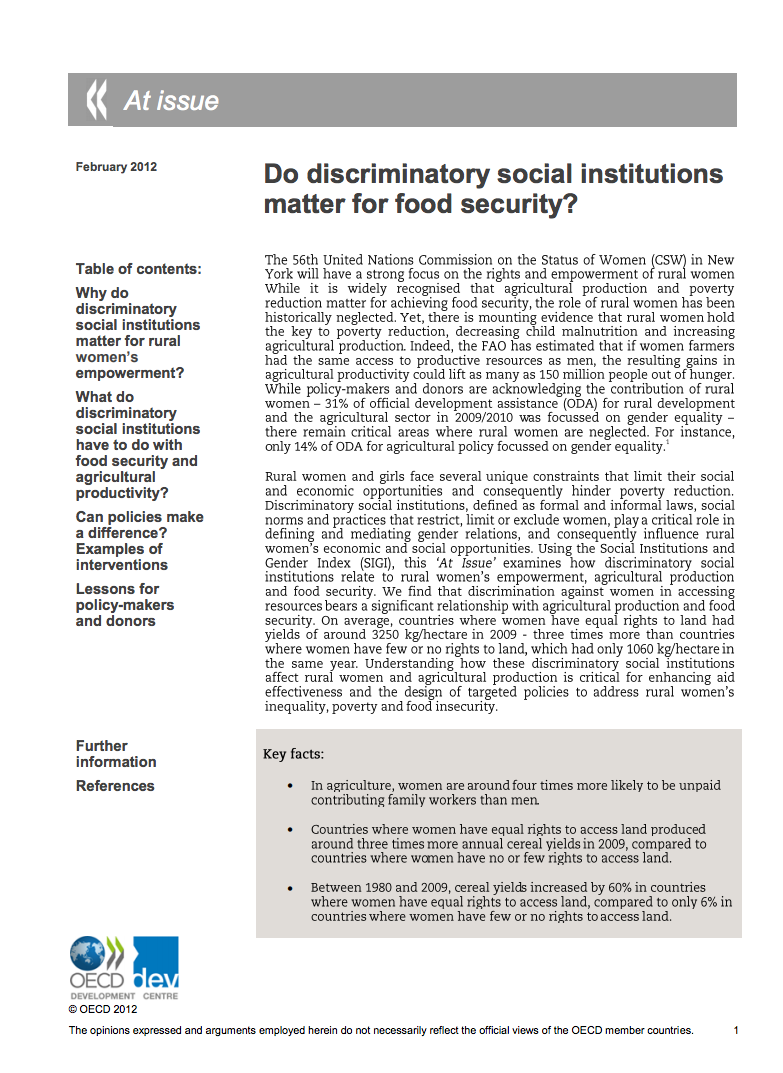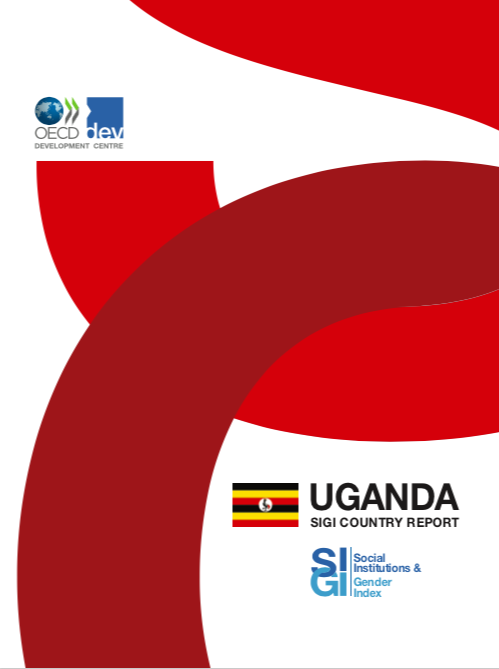
The Social Institution and Gender Index (SIGI) dataset address the de jure and de facto situations of discriminatory social institutions, combining both qualitative and quantitative data providing information information on laws, attitudes and practices across 180 countries. According to the original SIGI website:
"Discriminatory social institutions intersect across all stages of girls’ and women’s life, restricting their access to justice, rights and empowerment opportunities and undermining their agency and decision-making authority over their life choices. As underlying drivers of gender inequalities, discriminatory social institutions perpetuate gender gaps in development areas, such as education, employment and health, and hinder progress towards rights-based social transformation that benefits both women and men."
The first edition of the SIGI dataset was first launched in 2009, and then updated in 2012, 2014 and 2019. The SIGI 2019 is built around four sub-indices, namely discrimination in the family, restricted physical integrity, restricted access to productive and financial resources, and restricted civil liberties.

What are the objectives of the dataset?
The Social Institutions and Gender Index (SIGI) is an index designed to measure gender equality in a society. SIGI is a composite index of gender equality. It focuses on formal and informal social institutions that impact the roles of men and women, such as a society's norms, values and attitudes that relate to women. The variables span all stages of a woman’s life in order to show how discriminatory social institutions can interlock and bind them into cycles of poverty and disempowerment.
What is the methodology?
Higher values of the SIGI denote higher level of gender-based discrimination in formal and informal social institutions. The SIGI includes 27 variables combined into 16 indicators and 4 dimensions. The 27 variables include:
- 14 categorical variables describing the level of discrimination in legal frameworks (for all SIGI indicators but two: missing women and FGM) – these variables are based on 144 questions out of the 312 used to draft the SIGI country profiles;
-
3 attitudinal variables describing the level of discrimination in social norms; and
-
10 variables on prevalence rates describing the level of discrimination in practices.
More information on the SIGI 2019 methodology
What are the main results?
While assessing 180 countries overall, the SIGI ranks 120 countries for which full information over all the index sub-components is available. In order to assist the interpretation of the data and results, Countries are grouped by level of discrimination in five categories, with higher values of the index reflecting higher levels of discrimination:
-
Very Low (SIGI ≤ 20%): According to SIGI 2019, currently 32 countries, representing 27% of the countries ranked, have very low levels of gender discrimination in social institutions;
-
Low (20% < SIGI ≤ 30%): 43 countries (36% of the countries ranked) have low levels of gender discrimination in social institutions;
-
Medium (30% < SIGI ≤ 40): 16 countries(13% of the countries ranked) have medium levels of gender discrimination in social institutions;
-
High (40%<SIGI ≤ 50%): 17 countries, representing 14% of the countries ranked;
-
Very High (SIGI>50%): 12 countries, representing 10% of the countries ranked.
Currently, 24% of the countries ranked in the SIGI 2019 - that is almost one country every four - show high or very high levels of gender discrimination in social institutions.

Source: SIGI categories 2019
Who is involved?
The SIGI is an initiative of the Organization for Economic Cooperation and Development (OECD) Development Centre.
Related content on the Land Portal
SDGs: Indicator 5.a.2
Proportion of countries where the legal framework (including customary law) guarantees women’s equal rights to land ownership and/or control
Last updated on 1 February 2022
This indicator is currently classified as Tier II. The Food and Agriculture Organization of the United Nations (FAO) is the main Custodian agency. UN Women and the World Bank are partner agencies.
Does Gender Inequality Hinder Development and Economic Growth? Evidence and Policy Implications
Does the existing evidence support
policies that foster growth by reducing gender inequality?
The authors argue that the evidence based on differences
across countries is of limited use for policy design because
it does not identify the causal link from inequality to
growth. This, however does not imply that
inequality-reducing policies are ineffective. In other
words, the lack of evidence of a causal link is not in
SDGs: Indicator 5.a.1
(a) Proportion of total agricultural population with ownership or secure rights over agricultural land, by sex; (b) share of women among owners or rights-bearers of agricultural land, by type of tenure
Last updated on 1 February 2022
Promoting Gender Equity in the Democratic Process: women's Paths to Political Participation and Decisionmaking
How can women be integrated in processes of democratisation? The participation of women in political and economic processes is essential for democratic governance. The PROWID grants system supported activities such as lobbying and advocacy, skills development and developing institutions to further women's social and economic rights. This report looks at women's participation in political culture, civil society and government institutions. Importantly, it puts participation in the context of shifting gender (and other) roles and identities.
Burkina Faso Social Institutions and Gender Index (SIGI)
The Burkina Faso-SIGI country study is a tailor-made policy and research tool, adapting the methodology and conceptual framework of the global SIGI to the national context. The adapted Burkina Faso-SIGI framework is the result of consultations, workshops, in-depth research and field surveys.
Do discriminatory social institutions matter for food security?
In view of the 2012 United Nations Commission on the Status of Women’s thematic focus on rural women’s empowerment, the gender team at the Development Centre has launched an issues paper, “Do discriminatory social institutions matter for food security?”.
Uganda SIGI Country Report
The Uganda-SIGI shows that investments in reducing gender inequalities holdimportant potential to improve women’s rights and reduce gender gaps. Over the pasttwo decades, Uganda has achieved solid progress, courtesy of comprehensive laws andpolicies strengthening women’s political participation and land rights, among others.
However, gaps and challenges remain across some key areas affecting women’srights. Gaps between opinions, perceived and actual practices highlight the urgency to tackle discriminatory social institutions through a multi-pronged and holistic approach.
Except where additional restrictions apply, You can extract from, download, copy, adapt, print, distribute, share and embed Data for any purpose, even for commercial use. You must give appropriate credit to the OECD by using the citation associated with the relevant Data. (source OECD Terms and conditions).
Donors:
Download this Dataset data.











